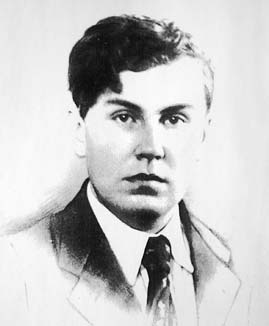


 تاريخ الرياضيات
تاريخ الرياضيات
 الرياضيات في الحضارات المختلفة
الرياضيات في الحضارات المختلفة 
 الرياضيات المتقطعة
الرياضيات المتقطعة
 الجبر
الجبر
 الهندسة
الهندسة 
 المعادلات التفاضلية و التكاملية
المعادلات التفاضلية و التكاملية 
 التحليل
التحليل
 علماء الرياضيات
علماء الرياضيات |
Read More
Date: 4-1-2018
Date: 25-12-2017
Date: 1-1-2018
|
Died: 21 June 1947 in Leningrad, Russia

Nikolai Sergeevitch Krylov entered the Department of Physics at Leningrad University in 1934 [2]:-
Even as a student he attracted general attention by his brilliant abilities and his desire through his own efforts to get to the bottom of the problems of theoretical physics that interested him. This ability to concentrate on and to penetrate into the object of his studies characterised Krylov throughout his scientific career, which began when he was still a university student.
Krylov graduated in 1939 but even before this he had written two papers which were published in 1940. These are On the foundation of physical statistics and On methods of obtaining Gibbs' distribution. After graduating, he continued to undertake research at Leningrad University, advised by V A Fock. He presented his candidate's thesis Mixing processes in phase space which he defended brilliantly in July 1941. Up to this time Krylov had been little affected by World War II, but in 1941 the Germans invaded Russia and by September German troops were on the outskirts of Leningrad cutting the city off from the rest of Russia. The city came under constant artillery and air bombardment and Krylov was assigned air defence duties. However, he would invariably be seen reading a book while on duty. It is quite incredible how he continued research, developing his ideas on statistical mechanics, while subjected to appalling suffering from shortages of supplies. About 660,000 people died in Leningrad during the siege from scurvy and starvation. The exceptionally bitter winter of 1941-42, when temperatures fell to -40° C, was one of extreme hardship for Krylov but he was evacuated and was able to recover his health in time to defend his doctoral thesis in Kazan (where Leningrad University had moved because of the war) in the summer of 1942.
The blockade of Leningrad was broken in January 1943, but it was into 1944 before the German troops were forced back from the surroundings. Krylov certainly could not return to Leningrad so he spent time working at the scientific centres in Elabuga, Joshkar Ola, and Moscow. By the autumn of 1944 Leningrad was able to start the process of recovery (much had been destroyed by the bombardment and much of what remained was destroyed by the Germans before they retreated). Krylov resumed his duties at senior scientist at the Physical Institute of Leningrad University. By the end of 1946 his health had begun to deteriorate and after months of severe illness he died in June of the following year.
A S Wightman wrote in the Preface to [1]:-
Krylov's place in the history of statistical mechanics is quite special. he came after the developments in probability theory and ergodic theory of the first three decades of this century which represented the first major impact of statistical mechanics on mathematics (the work of Poincaré, Birkhoff, von Neumann, Hopf, Kolmogorov, Khinchin, Wiener, ...). He tried, and in this he was ahead of his time, to re-examine the fundamental physical issues of statistical mechanics in the light of these new mathematical insights.
L A Bunimovich writes in a similar way in 1987:-
The outstanding Russian physicist N S Krylov died in 1947 at the age of 30. His works, in which he tried to re-examine the fundamental problems of statistical mechanics in the light of developments in ergodic theory and probability theory, were far ahead of his time. Some of his ideas still remain to be developed.
In 1946 Krylov began to write a monograph explaining his revolutionary ideas.
Note that in the introduction Krylov refers to the contents of the six chapters he intended to write. However at his death he had only completed Chapter 1 and most of Chapter 2. Chapters 3 to 6 and part of Chapter 2 were, sadly, never written.
Books:
Articles:



|
|
|
|
دراسة يابانية لتقليل مخاطر أمراض المواليد منخفضي الوزن
|
|
|
|
|
|
|
اكتشاف أكبر مرجان في العالم قبالة سواحل جزر سليمان
|
|
|
|
|
|
|
اتحاد كليات الطب الملكية البريطانية يشيد بالمستوى العلمي لطلبة جامعة العميد وبيئتها التعليمية
|
|
|